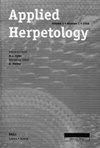Habitat correlates of five amphibian species and of species-richness in a wetland system in New South Wales, Australia
引用次数: 14
Abstract
We investigated the habitat correlates of five amphibian species and species-richness in freshwater ponds at a wetland site in New South Wales, Australia. The objective was to produce a simple model useful to wildlife managers in the area wishing to construct new ponds for the purpose of amphibian conservation. 43 ponds were surveyed in which we found 2-8 species. We recorded 35 habitat variables, and reduced these to a simpler set of non-correlated surrogate variables in Principle Component Analyses. Five species-specific models were constructed using logistic regression. Emergent vegetation, plant species diversity, pond water pH, salinity and bank slope were found to be predictor variables. A multiple regression analysis was used to investigate correlates associated with species richness. The species richness model showed larger ponds with a high proportion of surface area covered by emergent vegetation held most species of amphibian. There were no conflicts with the results from the species-specific models and the species richness model.澳大利亚新南威尔士州湿地系统中5种两栖动物的生境相关性及物种丰富度
研究了澳大利亚新南威尔士州某湿地淡水池塘中5种两栖动物的生境相关性及物种丰富度。其目的是为该地区的野生动物管理者提供一个简单的模型,以帮助他们建造新的池塘以保护两栖动物。调查了43个池塘,发现2-8种。我们记录了35个栖息地变量,并在主成分分析中将它们简化为一组更简单的非相关替代变量。利用logistic回归构建了5个物种特异性模型。结果表明,涌现植被、植物物种多样性、池塘水pH、盐度和岸坡为预测变量。采用多元回归分析研究了物种丰富度的相关关系。物种丰富度模型显示,水塘面积大,植被覆盖面积大,水塘中两栖动物种类多。与物种特异性模型和物种丰富度模型的结果没有冲突。
本文章由计算机程序翻译,如有差异,请以英文原文为准。
求助全文
约1分钟内获得全文
求助全文

 求助内容:
求助内容: 应助结果提醒方式:
应助结果提醒方式:


